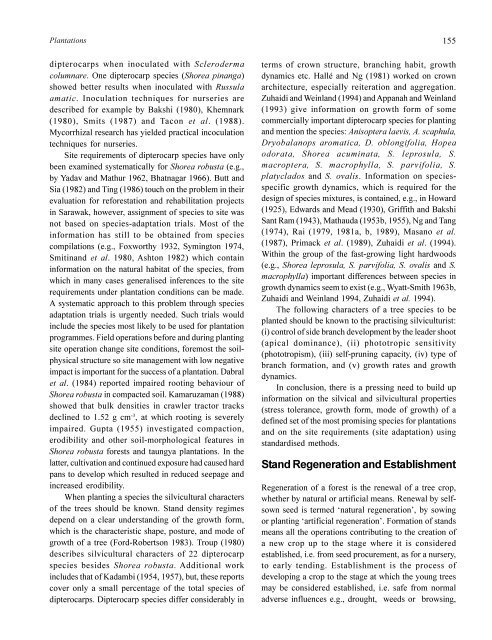A review of dipterocarps - Center for International Forestry Research
A review of dipterocarps - Center for International Forestry Research
A review of dipterocarps - Center for International Forestry Research
You also want an ePaper? Increase the reach of your titles
YUMPU automatically turns print PDFs into web optimized ePapers that Google loves.
Plantations 155<br />
<strong>dipterocarps</strong> when inoculated with Scleroderma<br />
columnare. One dipterocarp species (Shorea pinanga)<br />
showed better results when inoculated with Russula<br />
amatic. Inoculation techniques <strong>for</strong> nurseries are<br />
described <strong>for</strong> example by Bakshi (1980), Khemnark<br />
(1980), Smits (1987) and Tacon et al. (1988).<br />
Mycorrhizal research has yielded practical incoculation<br />
techniques <strong>for</strong> nurseries.<br />
Site requirements <strong>of</strong> dipterocarp species have only<br />
been examined systematically <strong>for</strong> Shorea robusta (e.g.,<br />
by Yadav and Mathur 1962, Bhatnagar 1966). Butt and<br />
Sia (1982) and Ting (1986) touch on the problem in their<br />
evaluation <strong>for</strong> re<strong>for</strong>estation and rehabilitation projects<br />
in Sarawak, however, assignment <strong>of</strong> species to site was<br />
not based on species-adaptation trials. Most <strong>of</strong> the<br />
in<strong>for</strong>mation has still to be obtained from species<br />
compilations (e.g., Foxworthy 1932, Symington 1974,<br />
Smitinand et al. 1980, Ashton 1982) which contain<br />
in<strong>for</strong>mation on the natural habitat <strong>of</strong> the species, from<br />
which in many cases generalised inferences to the site<br />
requirements under plantation conditions can be made.<br />
A systematic approach to this problem through species<br />
adaptation trials is urgently needed. Such trials would<br />
include the species most likely to be used <strong>for</strong> plantation<br />
programmes. Field operations be<strong>for</strong>e and during planting<br />
site operation change site conditions, <strong>for</strong>emost the soilphysical<br />
structure so site management with low negative<br />
impact is important <strong>for</strong> the success <strong>of</strong> a plantation. Dabral<br />
et al. (1984) reported impaired rooting behaviour <strong>of</strong><br />
Shorea robusta in compacted soil. Kamaruzaman (1988)<br />
showed that bulk densities in crawler tractor tracks<br />
declined to 1.52 g cm -3 , at which rooting is severely<br />
impaired. Gupta (1955) investigated compaction,<br />
erodibility and other soil-morphological features in<br />
Shorea robusta <strong>for</strong>ests and taungya plantations. In the<br />
latter, cultivation and continued exposure had caused hard<br />
pans to develop which resulted in reduced seepage and<br />
increased erodibility.<br />
When planting a species the silvicultural characters<br />
<strong>of</strong> the trees should be known. Stand density regimes<br />
depend on a clear understanding <strong>of</strong> the growth <strong>for</strong>m,<br />
which is the characteristic shape, posture, and mode <strong>of</strong><br />
growth <strong>of</strong> a tree (Ford-Robertson 1983). Troup (1980)<br />
describes silvicultural characters <strong>of</strong> 22 dipterocarp<br />
species besides Shorea robusta. Additional work<br />
includes that <strong>of</strong> Kadambi (1954, 1957), but, these reports<br />
cover only a small percentage <strong>of</strong> the total species <strong>of</strong><br />
<strong>dipterocarps</strong>. Dipterocarp species differ considerably in<br />
terms <strong>of</strong> crown structure, branching habit, growth<br />
dynamics etc. Hallé and Ng (1981) worked on crown<br />
architecture, especially reiteration and aggregation.<br />
Zuhaidi and Weinland (1994) and Appanah and Weinland<br />
(1993) give in<strong>for</strong>mation on growth <strong>for</strong>m <strong>of</strong> some<br />
commercially important dipterocarp species <strong>for</strong> planting<br />
and mention the species: Anisoptera laevis, A. scaphula,<br />
Dryobalanops aromatica, D. oblongifolia, Hopea<br />
odorata, Shorea acuminata, S. leprosula, S.<br />
macroptera, S. macrophylla, S. parvifolia, S.<br />
platyclados and S. ovalis. In<strong>for</strong>mation on speciesspecific<br />
growth dynamics, which is required <strong>for</strong> the<br />
design <strong>of</strong> species mixtures, is contained, e.g., in Howard<br />
(1925), Edwards and Mead (1930), Griffith and Bakshi<br />
Sant Ram (1943), Mathauda (1953b, 1955), Ng and Tang<br />
(1974), Rai (1979, 1981a, b, 1989), Masano et al.<br />
(1987), Primack et al. (1989), Zuhaidi et al. (1994).<br />
Within the group <strong>of</strong> the fast-growing light hardwoods<br />
(e.g., Shorea leprosula, S. parvifolia, S. ovalis and S.<br />
macrophylla) important differences between species in<br />
growth dynamics seem to exist (e.g., Wyatt-Smith 1963b,<br />
Zuhaidi and Weinland 1994, Zuhaidi et al. 1994).<br />
The following characters <strong>of</strong> a tree species to be<br />
planted should be known to the practising silviculturist:<br />
(i) control <strong>of</strong> side branch development by the leader shoot<br />
(apical dominance), (ii) phototropic sensitivity<br />
(phototropism), (iii) self-pruning capacity, (iv) type <strong>of</strong><br />
branch <strong>for</strong>mation, and (v) growth rates and growth<br />
dynamics.<br />
In conclusion, there is a pressing need to build up<br />
in<strong>for</strong>mation on the silvical and silvicultural properties<br />
(stress tolerance, growth <strong>for</strong>m, mode <strong>of</strong> growth) <strong>of</strong> a<br />
defined set <strong>of</strong> the most promising species <strong>for</strong> plantations<br />
and on the site requirements (site adaptation) using<br />
standardised methods.<br />
Stand Regeneration and Establishment<br />
Regeneration <strong>of</strong> a <strong>for</strong>est is the renewal <strong>of</strong> a tree crop,<br />
whether by natural or artificial means. Renewal by selfsown<br />
seed is termed ‘natural regeneration’, by sowing<br />
or planting ‘artificial regeneration’. Formation <strong>of</strong> stands<br />
means all the operations contributing to the creation <strong>of</strong><br />
a new crop up to the stage where it is considered<br />
established, i.e. from seed procurement, as <strong>for</strong> a nursery,<br />
to early tending. Establishment is the process <strong>of</strong><br />
developing a crop to the stage at which the young trees<br />
may be considered established, i.e. safe from normal<br />
adverse influences e.g., drought, weeds or browsing,

















